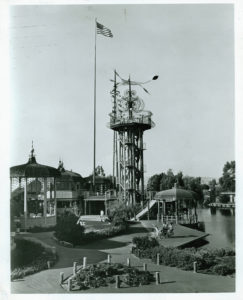History
Today, thousands of travelers enjoy tropical vacations without ever having to cross an ocean, all because of the curiosity of one Portuguese explorer, our far-sighted San Diego city fathers, and an imaginative Hollywood movie producer.
Long before Paradise Point was known as San Diego’s Island Resort, the 4,600-acre watery wonderland that it sits within was discovered by Portuguese shipbuilder and navigator Juan Rodrigues Cabrillo in 1542. (Cabrillo National Monument at the tip of Point Loma commemorates his discovery of the California coast.) Disenchanted with the bay because it was not sufficiently deep to accommodate his ships, Cabrillo named the area Bahia Falza or “False Bay.”
Hundreds of years later in 1902, George Hall, city horticulture commissioner, suggested that the swamp Bahia Falza be developed into an aquatic park. After more than 50 years, a master plan for the Mission Bay Aquatic Park was approved by the city council in 1958, and dredging soon followed. The $60 million project created 30 miles of shoreline beaches, grassy knolls, areas for sailing, swimming, picnicking, powerboats, fishing, water skiing, SeaWorld and Paradise Point.

The first guests to stay at vacation village in June 1962.
Enter movie producer Jack Skirball who, weary of building sets only to watch them being torn down at the completion of a film, was introduced to the grounds in 1962, and immediately saw its potential. He envisioned a permanent fantasy-island setting that would feature family vacationers as the cast. Skirball enlisted architect Eldridge Spencer and builder Bob Golden to help implement his ideas, and the trio worked in concert to create an extraordinarily stunning and unique vacation island escape that was insulated from the city, but not isolated.
Artifacts driven from Skirball’s film-making ideas were incorporated around the property, such as the porpoise fountain as well as decorative masonry that adorns the entries to the original cottages and the original mission bells along El Camino Real — the historic north-south coastal roadway of Old California.

Located in the heart of the island, the iconic observation tower was part of the resort’s original construction in the early 60s.
The rabbi-turned-movie-producer-turned-hotelier and his enthusiastic team created an exotic South Seas atmosphere with skillful placement of lagoons and waterfalls. An abundance of tropical and subtropical flowers and foliage amongst the cabana-style cottages gave each a picturesque view of Mission Bay, lagoons or tropical gardens. Skirball named it Vacation Village and its reality at the time was 150 guestrooms, one restaurant, two tennis courts and a small golf course. With continuing expansion and renovation over the next 40 years, the facilities came to include two unique and exciting restaurants overlooking spectacular Mission Bay, 462 luxurious guest cottages, and a relaxing lobby. Other guest amenities that were added include 5 lit tennis courts, 5 swimming pools, a full-service spa, a state-of-the-art fitness center, an 18-hole golf putting course, a full-service marina, bicycle rentals and more.
Today, what has come to be known as Paradise Point offers a convenient, beachfront location, providing travelers with easy access to all of San Diego’s attractions. The San Diego area resort is adjacent to SeaWorld Adventure Park and a short drive to Balboa Park where the world-famous San Diego Zoo is located.

